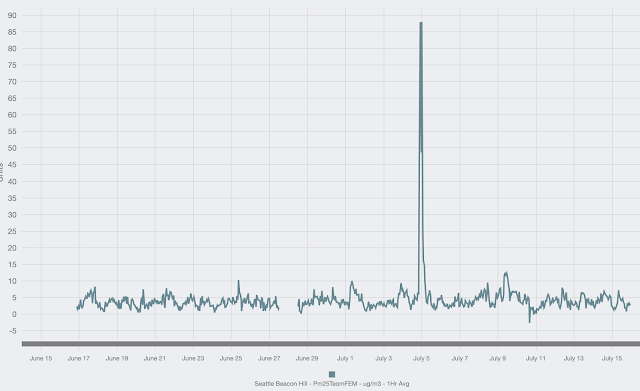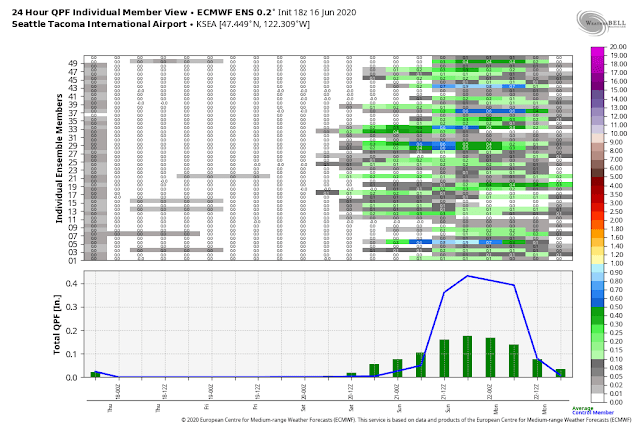Did this huge exposure result in increased spread of COVID-19? The answer is clearly no.
Consider Washington's King County, a hotbed of protests starting 26 May (see below). Both hospitalizations and deaths showed no upward spike after the protests (the blue line shows May 26th). We should have seen a signal by now, since the average time to symptoms is approximately five days.
It is important to note that the number of COVID-19 cases is going up modestly in King County, but that is being driven by a near doubling of tests (note that the bottom graph starts earlier). Much of the media neglects to note the importance of increased testing in finding more cases.
This lack of a coronavirus spike has been noted in every major city in the U.S., something discussed in the Seattle Times today and in many media outlets.
These are huge number of independent experiments in varying environments and climates. A very good sample. And the obvious conclusion is that COVID-19 has a very difficult time spreading in outdoor air. There is no other explanation.
Some of you might argue that many of the protestors were young and so would not get very ill. True enough. But young people can get sick from it and they could certainly give it to their parents, neighbors, and folks in food stores and restaurants. There were plenty of teenagers and folks in their early 20s still living at home who were at the protests.
You want more evidence? No problem. About a month ago, there was a huge media commotion about "irresponsible" outdoor parties at Missouri's Lake of the Ozarks (see picture below from the famous "party cove". Several media outlets promised a huge uptick in COVID-19 cases.
What actually happened? Nothing. No spike of COVID-19 cases in the neighboring counties. Outdoor air is safe.
________________________________________________________________________________
________________________________________________________________________________
The lack of outdoor transmission is consistent with the scientific literature. There is in fact no documentation of effective outdoor transmission of coronavirus (see my earlier blog for documentation). Some examples of scientific papers discussing the issue, include:
Qian et al., 2020: Examined 1245 confirmed cases in 120 cities in China and identified only a single outbreak in an outdoor environment, which involved two cases.
Nishiura et al., 2020: Transmission of COVID-19 in a closed environment was 18.7 times greater compared to an open-air environment (95% confidence interval).
The reasons for a lack of outdoor transmission are clear:
We have folks going outside with great fear, even wearing masks when they are alone or distant from others.
The other day I was biking down the Burke Gilman trail and an older women saw me coming and fled off the trail, pushing her mask tight around her mouth as she turned to face away from me. There was profound fear in her eyes and it was completely unnecessary. Really bothered me.
And such fear is being stoked by local politicians and governments. The City of Seattle parks STILL has many of the parking lots closed and threatening signs everything.
Completely inconsistent with scientific evidence and even the Mayor's Office's own statement on the lack of transmission during the protests. Talk about being anti-science and irrational.
Take a look at the welcome provide by Seattle Parks and Recreation for Magnuson Park, one of the city's jewels. Why does the Mayor allow this situation to continue? City parks should be completely opened.
_______________________________________________________
Additional Material
One commenter noted that percentage of positive test are increasing recently, indicating viral spread. This is true. But as shown by the plots of positive percentiles for Washington State (and daily tests), the rate of positives fell for WEEKS after the protests (which started at the time of the blue line). The minimum was in mid-June. The positive percentage is a very fast reacting measure of increase of COVID-19 transmission and there is NO hint of a surge with the advent of the protests. More recent rises, in WA and for most of the country, are associated with lessening of restrictions and lockdowns.
PS: Wearing masks is a very, very good thing if you are indoors. More than a good thing-- necessary in all public indoor spaces.
Qian et al., 2020: Examined 1245 confirmed cases in 120 cities in China and identified only a single outbreak in an outdoor environment, which involved two cases.
The reasons for a lack of outdoor transmission are clear:
- Virus concentration are low outdoors because of the tremendous dispersion of the virus in the outside environment. This results in low viral concentration.
- Solar radiation rapidly kills the virus.
- Higher humidity in the outside air is bad for transmission.
- Social distancing is much easier outside.
We have folks going outside with great fear, even wearing masks when they are alone or distant from others.
The other day I was biking down the Burke Gilman trail and an older women saw me coming and fled off the trail, pushing her mask tight around her mouth as she turned to face away from me. There was profound fear in her eyes and it was completely unnecessary. Really bothered me.
And such fear is being stoked by local politicians and governments. The City of Seattle parks STILL has many of the parking lots closed and threatening signs everything.
Completely inconsistent with scientific evidence and even the Mayor's Office's own statement on the lack of transmission during the protests. Talk about being anti-science and irrational.
Take a look at the welcome provide by Seattle Parks and Recreation for Magnuson Park, one of the city's jewels. Why does the Mayor allow this situation to continue? City parks should be completely opened.
_______________________________________________________
Additional Material
One commenter noted that percentage of positive test are increasing recently, indicating viral spread. This is true. But as shown by the plots of positive percentiles for Washington State (and daily tests), the rate of positives fell for WEEKS after the protests (which started at the time of the blue line). The minimum was in mid-June. The positive percentage is a very fast reacting measure of increase of COVID-19 transmission and there is NO hint of a surge with the advent of the protests. More recent rises, in WA and for most of the country, are associated with lessening of restrictions and lockdowns.
PS: Wearing masks is a very, very good thing if you are indoors. More than a good thing-- necessary in all public indoor spaces.






















































